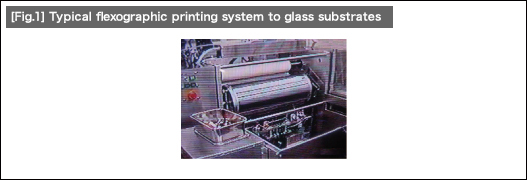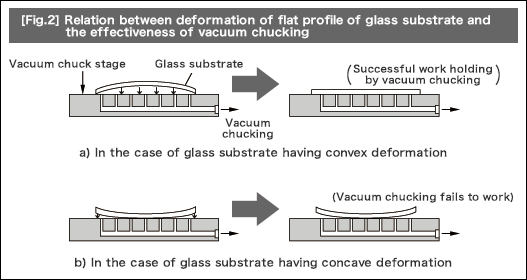#291 Know-how on automation: Positioning - 9
General description
-As a prerequisite for realizing precise positioning, it is essential to firmly hold every work. For glass substrates, silicon wafers, and other thin sheet-like works, mechanical holding is difficult to adopt. As a result, vacuum chucking on the surface of the stage is often applied. In this method, however, the vacuum chucking may not work effectively in some cases for thin sheet works transferred onto the stage, depending on their flat conditions. To ensure consistent vacuum chucking, flatness of acceptable works must be standardized, or every work must be mechanically pressed against the stage surface to make the work flat for vacuum chucking.
Explanation
-In the case of glass substrates, silicon wafers, and other thin sheet-like works, work-holding based on the vacuum chucking is often adopted in the equipment in the process of printing on the front side of a substrate (Figure 1).
-This is due to the difficulty in adopting mechanical clamping for the thin sheet-like works and the ease of attaining the environment (ease of control of temperature, pressure, airflow, and other factors) necessary for assuring consistent quality in the printing process. This allows simplified mechanical structure by nature, thus providing advantages of increased cost effectiveness, including lower system prices and shorter tact time.
-This vacuum chucking method has a disadvantage of being susceptible to variations in the initial flatness of works being chucked.
-To absorb the plate thickness variations, the positioning mechanism must have the following characteristics:
-Figure 2 illustrates how the effectiveness of vacuum chucking depends on the flat condition of works (glass substrates) being chucked.
-In the case of vacuum chucking method, those works that have the flat profile with the outer region contacting the stage (convexly deformed) are vacuum-chucked more effectively (Figure 2-a)).
-In contrast, those works that have a flat profile with the outer region warped upward (concavely deformed) are less effectively vacuum-chucked (Figure 2-b)).
-To eliminate the susceptibility to different flat profiles of works being chucked, two (2)solutions are available as listed below.
1.To adopt the specifications for the initial flat profile of works being chucked. (Figure 3) → To eliminate loading of any concave-deformed works exceeding the specifications.
2.To incorporate the mechanical structure designed to press every work to be chucked against the stage from above in advance of vacuum chucking.(Investment to be required)
Precautions:
-The flat profile of thin sheet-like works greatly depends on the thin sheet-forming process of the works. Regarding glass substrates and silicon wafers, possible factors include the difference in the balance of residual stresses between the two sides, front and back, caused in the formation of thickness and/or in the polishing process for realizing surface roughness. Thus, for the established consistent quality of flatness, proper control of processing steps is essential.



- Positioning technology
- Designing and processing
- Sensor Technology
- Automation elements technology
- Clean room technology
- Design hints
- Design tips
- Designing and Machining
- Drive mechanism design
- Hints on designing
- Linear Motion Components
- Locating Technology
- Manufacturing technology
- Motion mechanism design
- Pneumatic Drives
- Production Technology
- Technology Outlook
- General description
- Low-cost automation and materials
- Transfer LCA
- #333 Know-how on automation: Pressurized heating technology - 5: Multilayer pressurized heating process technique
- #332 Know-how on automation: Pressurized heating technology - 4: Points to remember when designing mechanism of pneumatic pressurization method
- #331 Know-how on automation: Pressurized heating technology - 3: Pneumatic pressurization method and pressure profile
- #330 Know-how on automation: Pressurized heating technology - 2: Pressurization method and pressure profile
- #329 Know-how on automation: Pressurized heating technology



